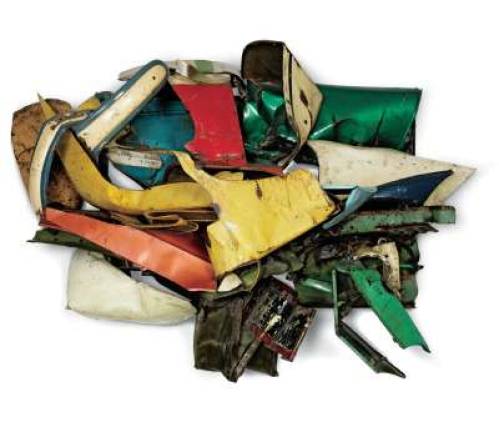Tribute to Dynamism: The ageless sculptures of John Chamberlain

by Jim Long John Chamberlain's sculptures ofcrushed automobile metal are as immediatelyiconic as Hokusai's wave. Carefulto explain that the material he used wasnot found but chosen, Chamberlainconceived sculpture as groups of semichaoticmodules that could be coaxed to fit, and the result seemed the mostnatural thing for sculpture to be: uncontrived,casual masterworks. Like de Kooning, whose work headmired, Chamberlain's subject matterwas most often girls, jazz and cars.He found a way to sculpt color, and the"dynamic obsolescence" of Detroit'sindustry insured he would have anunending supply of extremely sophisticatedmaterial. (At GM, Harley Earl anda staff of 75 developed color intentionallyto create deluxe objects; economicallyand socially seductive.) It was noaccident the sculptor admired the paintingof de Kooning: the Dutch painterwas choosing his "American" palettefrom the advertising of the day. Chamberlain's Guggenheim retrospectivebegins with the amazing"Doomsday Flotilla" (1982), a sevenpart,floor-hugging hellish armada ofskeletal lengths of black chassis parts fitted out with cream colored sails andchrome engines. It's a blast of Dantesqueradical imagination. On the back wallhangs the relief "Essex" (1960).Works on the ramp spiral upwardin roughly chronological order, mixingwall reliefs with free-standing objects."Calliope" (1954) is an early work borrowingits sculptural vocabulary fromDavid Smith. Nearby, we see "Shortstop" (1958),a breakthrough assemblage of rusty fenders. Chamberlain developed the fitby repeatedly running over them untilthey resembled a baseball mitt. Thisconvergence of instinctive choice ofmaterial and random act wouldinform his workfor the followingdecades. The hydraulic balersoon becameChamberlain'stool of choice,although asledgehammer was employedfor finesse work. In the work ofthe early 1960she was able tobring an organicand voluminouslightness to thesteel, contradictingits actualweight. Theworks pulse withelusive convolutions, as do the titles."Miss Lucy Pink" (1962) sports an eyeand floppy ear. In minimalism's moment,Chamberlain collapsed grid, line andplane all at once. After a seven-year filmmakingbreak from sculpture in the '60s,he returned with unique versions of figurationand brittle vegetal forms. Duringthe five years before his recent untimely death, however, he began working againwith automotive metal, carefully chosen"vintage" colors from the '40s and '50s.These bring back scale and volume tosome of his most monumental work,completing the multifaceted self-portraitof this profound artist. John Chamberlain: Choices Through May 13, Solomon R. Guggenheim Museum, 1071 5th Ave., 212-423-3500, www.guggenheim.org/new-york. This article first appeared in the March 7 issue of CityArts. For more from New York's Review of Culture, visit www.cityartsnyc.com